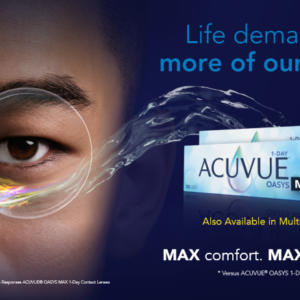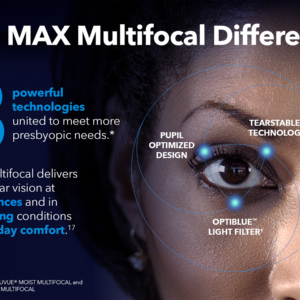sponsored content
September 12, 2023
Today’s presbyope is very different than those from years ago; they are more active and involved. In my San Diego optometry practice, most of my presbyopic patients reflect this and simply don’t want to be encumbered with glasses. With the introduction of ACUVUE OASYS MAX 1-Day MULTIFOCAL, I’ve been fortunate that now most of my presbyopic patients will have a new-found freedom brought on by the convenience, comfort and vision of these lenses.1 I’m happy to be able to provide a treatment option for a problem many have been dreading since their presbyopic symptoms escalated.
My office makes a point to always inform our patients about the newest technologies; this starts with the booking of an appointment. If the patient is in their presbyopic years, we take the opportunity to inform them about ACUVUE OASYS MAX 1-Day MULTIFOCAL contact lenses. Additionally, I ask every patient who comes into our office, even if they’re scheduled for a glasses-only exam, if they have any interest in contact lenses. I follow up by asking if there are any activities they would like to do without glasses. Take this time to capture the patient who has always wondered about contact lenses but is too afraid to ask; many times they’ve been told or assume they can’t wear contacts, they are very often excited at the opportunity that they may be a candidate.
Identifying the Multifocal Candidate
When it comes to finding the ideal patient, anyone who doesn’t have an immediate phobia of touching their eyes in my opinion is a good candidate for contact lenses. As far as multifocal contacts for presbyopes, this can be people in their late 30s who experience difficulty with up-close vision and need improved near and intermediate vision capabilities. Often these patients are emerging presbyopes and their accommodative demands are now causing them to have asthenopic complaints that a multifocal could solve. I’ve found that if you don’t ask, patients don’t always tell you. So, it’s our job to really tease out what’s going on with their vision.
In my experience, many patients 35 and older who are engaged in a lot of near work are actually emerging presbyopes and thus good candidates for multifocal contact lenses. If they’re already wearing multifocal contacts, they may be having associated dryness with some of the older soft contact lens material technologies or not achieving the near vision quality they need. Even if they don’t want to switch to contact lenses all the time the daily disposable modality gives them the option of being able to do activities without glasses sliding around their face.
Tips for Successful Fittings
When it’s time to fit patients with ACUVUE OASYS MAX 1-Day MULTIFOCAL contact lenses, the ACUVUE fit guide helps me to achieve fit success in 3 easy steps.2 For step one, you want to do a careful subjective refraction, and one of the key things that many of us have forgotten since we took boards is the red-green balance to ensure we don’t over minus.
Sighting Method Versus Sensory Dominance
In step two, determine the dominant eye, and there are two ways to do this. We have all done the sighting method where we have a card with a hole in it, or we have patients put their hands together and make a little triangle. We have some letters on the chart and we ask patients to put the letter through the hole. This is sighting dominance, which determines sighting preference. This method is great to determine which eye should be used to view a scene through a camera. This is different from sensory dominance, which tells us which eye has the greatest sensitivity to plus defocus; thus, the eye we never want to make blurry when inducing disparity between the eyes. Sensory dominance is the test where you take a +1.50D trial lens and ask the patient which eye seems blurrier or bothers them more as you place the lens over each eye individually with both eyes open over their best corrected vision. The eye which is more bothered or blurry is the dominant eye.
The Functional Add
Step three, the functional add, is the minimum add needed where the patient likes to hold reading material. It’s important to understand multifocal contact lenses are not the same as a progressive spectacle prescription. We should think of these lenses as we would prescribe a standard bifocal. So, let’s take the example of a 55-year-old patient who has a working distance of 18 inches. That means the accommodative demand is 2.22D. At 55 according to Donders the amplitude of accommodation in a well refracted patient is 1.5D, so following what we were taught in optometry school the ideal add should be 2.22 -0.75 or 1.47D. We would round this to an add of +1.50D, thus a mid-add in the ACUVUE system. If prescribing a progressive add many doctors might prescribe more for fear the add may not cut out. Remember these lenses are not progressive spectacle adds, so prescribe as we were taught in school. The general rule of thumb is the 40s, 50s, and 60s rule – in their 40s, patients are usually going be in the low-low lenses; in their 50s, they’ll be in a mid-mid combination; and in their 60s, they’ll be in a mid-high combination. The fit guide never recommends a high-high combination.
Each manufacturer has a unique optical design which then leads to their fit guide, this is why you need to leverage the fit guide associated with the lens you are using; there is no universal fit guide.
Digital Fitting Calculator
ACUVUE has a digital multifocal calculator to help choose the right lenses. Just put in your subjective refraction, patients’ age, dominant eye and your measured add. There is no need to vertex correct or determine spherical equivalent – the calculator will do it for you! Finally, click calculate. It will suggest to you which lenses to pick and how to troubleshoot if you need better distance or near vision. I highly recommend you use this tool as it helps avoid common errors and, in my opinion, can help to expedite the fitting process.
Why the MAX Multifocal Contact Lens is Different
The ACUVUE MULTIFOCAL leverages the PUPIL OPTIMIZED DESIGN. The unique aspect of this design is each lens in the fitting set has a different power profile that was designed to match the variation in pupil size that occurs due to refractive error and age.3 This means that the distance to near ratio of each lens should be similar if the power profile matches the variation of the pupil; a +3D Mid lens is much different than a -3 D Mid lens. The benefit of this is that we don’t need to apply the “fudge factor” that we may have done with older non pupil optimized designs. We all have done this, after vertex correcting a -6D myope we then adjust the prescription down to maybe a -5.25. We’ve been told this is the “art” of fitting a presbyope. With the ACUVUE design I don’t need to do this “fudge factor”; I vertex correctly, follow the fit guide and very often I’m successful; the science of fitting is so much better in my opinion.
Another unique property of the ACUVUE OASYS MAX 1-Day multifocal and the sphere is the TearStable technology. This technology is a result of a state-of-the-art manufacturing process that has resulted in an optimization of the distribution of the wetting agent.#4-6 The clinical result of this is a reduction of the evaporation rate compared to other major brands and even lower than OASYS 1-Day.*4,6 Reducing the evaporation rate should lead to improved comfort and vision.7
The Lens Featuring the Unique OptiBlue Light Filter†
This is the only multifocal brand that has a blue light filter.^,†,‡,3,8 The OptiBlue Light Filter† is the WOW factor for many of my patients. It has a 60% blue violet light filter.†,§,4,6 The coatings on most glasses are 20% to 40%, so it has more filtering than even most glasses.
These contact lenses actually improve visual clarity by reducing halos and starbursts.**4,5,12 If your patients are seeking multifocal contact lenses to reduce light scatter throughout the day, or for vision clear enough to drive at night, ACUVUE OASYS MAX 1-Day MULTIFOCAL may be right for them.††1,9 Having a lens aimed at improving subjective vision is ideal especially for the presbyopic patient.
Great for Patients and Your Bottom Line
Multifocal contact lenses are going to bring more financial benefits to your practice than relying solely on spectacles.10,11 There are plenty of rebates for ACUVUE OASYS MAX 1-Day Multifocal contact lenses; these rebates have made this lens affordable for most of my patients. Once patients try them and see the benefits, the cost is less of a barrier. Educate your patient on the technologies of these lenses and explain how they can address their individual needs. When we inform our patients why we chose a specific brand for them and how it will address their needs, they can make a well-informed decision and value our services to them.
Dr. Melody Tavakoli, OD is an optometrist in San Diego.
¶JJV Data from the ACUVUE OASYS MAX 1-Day In-Practice Assessment, with 81 participating Optometrists and 605 spherical and 390 multifocal patients in the US from July to October 2022.
#Versus Dailies Total1, My Day and Infuse, also significantly lower versus ACUVUE OASYS 1-Day.
*Versus ACUVUE OASYS 1-Day, Dailies Total1, My Day, Infuse and Precision 1
†Filtering of high-energy visible light by contact lenses has not been demonstrated to confer any health benefit to the user, including but not limited to retinal protection, protection from cataract progression, reduced eye strain, improved contrast, improved acuity, reduced glare, improved low light vision, or improved circadian rhythm/sleep cycle. An eye care professional should be consulted for more information.
‡Versus publicly available information as of June 2022.
^Major brand contact lens manufacturers are Johnson & Johnson Vision Care, Alcon Inc, Bausch & Lomb and CooperVision, representing a total of 88.1% of the multifocal market share as of June 2022.
§Versus publicly available information for standard daily use contact lenses as of June 2023.
**Versus ACUVUE OASYS 1-Day.
††Versus ACUVUE OASYS Multifocal.
References
1 JJV Data on File 2022. Subjective Stand-Alone Claims for ACUVUE OASYS MAX 1-Day MULTIFOCAL Contact Lenses – Exploratory Meta-analysis.
2 JJV Data on File 2020. ACUVUE OASYS MULTIFOCAL Fit and Performance Claims.
3 JJV Data on file 2022. CSM- ACUVUE PUPIL OPTIMIZED DESIGN Technology: JJVC contact lenses, design features, and associated benefits.
4 JJV Data on File 2022. TearStable Technology Definition.
5 JJV Data on File 2022. Effect on Tear Film and Evaluation of Visual Artifacts of ACUVUE OASYS MAX 1-Day Family with TearStable Technology.
6 JJV Data on File 2022. Material Properties: 1-DAY ACUVUE MOIST, 1-DAY ACUVUE TruEye, ACUVUE OASYS 1-Day with HydraLuxe Technology and ACUVUE OASYS MAX 1-Day with TearStable Technology Brand Contact Lenses and other daily disposable contact lens brands.
7 Nichols JJ, Willcox MDP, Bron AJ, et al. The TFOS International Workshop on Contact Lens Discomfort: Executive Summary. Invest Ophthalmol Vis Sci. 2013, 54:TFOS7-TFOS13.
8 Lasky J. VIS-TD-108916/1: HEVL/Blue Violet Blocking Contact Lens Secondary Landscape Search. 2022
9 JJV Data on File 2023. Evaluation of Visual Artifacts with ACUVUE OASYS MAX 1-Day MULTIFOCAL vs ACUVUE OASYS MULTIFOCAL Contact Lenses.
10 Ritson M. Which patients are more profitable? Contact Lens Spectrum. March 2006;38-42.
11 Edward S. Building a practice with multifocal lenses. Contact Lens Spectrum, Volume: 33, Issue: August 2018, page(s): 36, 38, 39
12 JJV Data on File 2022. Blue-Violet Filter Utilized in ACUVUE OASYS MAX 1-Day contact lenses.
——————————–
Important Safety Information: ACUVUE Contact Lenses are indicated for vision correction. As with any contact lens, eye problems, including corneal ulcers, can develop. Some wearers may experience mild irritation, itching or discomfort. Lenses should not be prescribed if patients have any eye infection, or experience eye discomfort, excessive tearing, vision changes, redness or other eye problems. Consult the package insert for complete information. Complete information is also available from Johnson & Johnson Vision Care, Inc. by calling 1-800-843-2020, or by visiting https://www.jnjvisionpro.com/.
PP2023MLT5926





